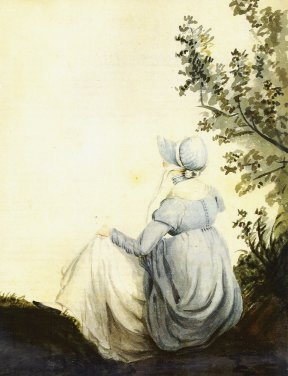And thus to the blog post by Lauren Gilbert, historical novelist, that started this whole series on the connections between Jane Austen and Mary Wollstonecraft. Did the former read the latter? She begins with some good old fashioned archival research, of the sort that turned up the father of Claire Clairmont:
So far, this is more or less what we already knew from part two, Margaret Kirkham's research decades ago. But it goes on to mention a Lost Son to add to my little list of people influenced by Mary.I contacted Jane Austen’s House and Museum, Bath Central Library, Jane Austen Centre, and Chawton House Library. No catalog of Rev. George Austen’s library is known to exist. (Jane Austen’s House and Museum does have a copy of the inventory of the contents of the Steventon Rectory but no catalog of his books.) The Bath Central Library indicated that VINDICATION was on the catalog for Marshalls Circulating Library on Milsom Street dated 1808; it is the only one they have in Jane’s time frame. Since VINDICATION was published in 1792 and was a well-known work, this argues that the book was probably available via a circulating library when Jane Austen lived in Bath, or visited in London or other cities.
Lauren Gilbert concludes that JA "was exposed to and affected by" and indeed "profoundly influenced by" the second Vindication. "That Mary Wollstonecraft’s work was known to Jane Austen is not a point of serious debate that I can find." This agrees with what Lyndall Gordon says (part three in our series). JA's novels serve as warnings of what happens when women are raised to be, as Mary put it, "alluring mistresses" rather "than affectionate wives and rational mothers". The blogpost ends by claiming "almost direct references" in the novels to the polemic. Everyone's favourite spinster novelist:Jane is known to have had a copy of HERMSPRONG, or man as he is not by Robert Bage (philosophically, Mr Bage embraced the idea of the superiority of the “natural man”, considered women the equal of man and supported women’s rights, and was known to have had a high regard for Mary Wollstonecraft; these ideals are demonstrated by the story in HERMSPRONG). Jane’s copy is in the Huntington Library (her signature in all 4 volumes). This would argue a mind open to the ideas expressed in VINDICATION. There is also a theory that Jane would not necessarily referred to Mary Wollstonecraft’s work or influence, due to Mary’s unconventional morals and lifestyle (see Claire Tomalin and Miriam Ascarelli).
This is in agreement, in more restrained form, with the enthusiastic theories of Arnie Perlstein, part four in our series, who holds JA to be a secret radical feminist: if you hold the texts up to the candleflame in the right way, the invisible lemon juice darkens, and the hidden message become legible.... with her light touch and subtle humor, highlighted the issues Ms. Wollstonecraft raised. While she could not very well have acknowledged this influence at the time she published, Ms. Wollstonecraft’s reputation being what it was, I think Jane Austen clearly carried Ms. Wollstonecraft’s ideas regarding the education of women, and a higher concept of marriage, forward.
Next up: a whole book on Women in Revolutionary Debate: Female Novelists from Burney to Austen. And the Loiterers - like the current Idler, not dawdling at all.
Jane Austen, by her sister Cassandra. (1773-1845) [Public domain], via Wikimedia Commons
-----------------------------------------
Part of a linked series: Jane Austen: a lost daughter? Part one, Part two: Kirkham and Ascarelli, Part three: Gordon, Part four: Perlstein, Part five: Gilbert, Part six: Russo and Broemel.
Part of a very loose series on lost daughters and sons: Margaret King (Mrs Mason) , Millicent Garrett Fawcett, C19 American women's rights advocates, Claire Clairmont, Voltairine de Cleyre, William Gladstone, Ayaan Hirsi Ali, Amartya Sen
Part of a linked series: Jane Austen: a lost daughter? Part one, Part two: Kirkham and Ascarelli, Part three: Gordon, Part four: Perlstein, Part five: Gilbert, Part six: Russo and Broemel.
Part of a very loose series on lost daughters and sons: Margaret King (Mrs Mason) , Millicent Garrett Fawcett, C19 American women's rights advocates, Claire Clairmont, Voltairine de Cleyre, William Gladstone, Ayaan Hirsi Ali, Amartya Sen

Thank you for this post, Roberta! While I am not comfortable with the term "secret radical feminist," due to the term feminist's modern connotation, there can be no doubt that Jane's novels underscore the inequities between men and women in her time. I'm not even sure that "secret" is that accurate, as we see it, and I feel that at least some of her contemporary readers would have seen it, too. She also alludes to certain other societal ills as well, with the same delicate touch. This serves to establish that Jane Austen was not solely writing for light entertainment, and (in my mind) is one of the reasons for her continuing popularity.
ReplyDeleteLauren - so glad you are enjoying this series! I hope you stick around; your comments are appreciated. Of course you are correct that the terms "feminism" and "feminist" did not exist in this sense until the late nineteenth century. (The OED gives the earliest citation as 1895, and says it came from the French.) I re-dipped into Northanger Abbey, as you'll see in my next post, and it is rich with allusions. Henry Tilney is quite an advocate. I can see no secret about Jane Austen's feelings regarding the cramped education and role allocated to girls and women then.
ReplyDelete